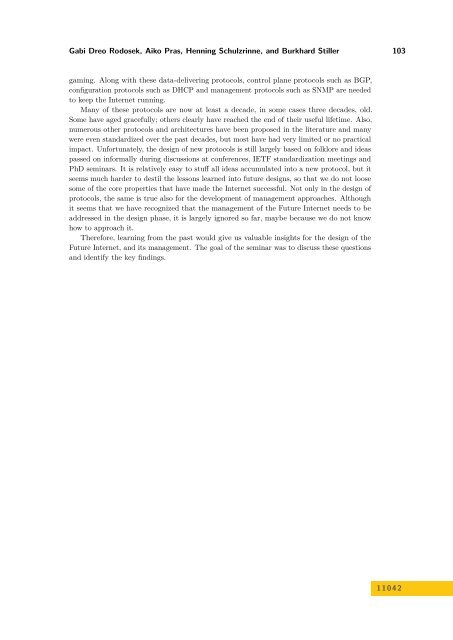Volume 1, Issue 1, January 2011 - DROPS - Schloss Dagstuhl
Volume 1, Issue 1, January 2011 - DROPS - Schloss Dagstuhl
Volume 1, Issue 1, January 2011 - DROPS - Schloss Dagstuhl
You also want an ePaper? Increase the reach of your titles
YUMPU automatically turns print PDFs into web optimized ePapers that Google loves.
Gabi Dreo Rodosek, Aiko Pras, Henning Schulzrinne, and Burkhard Stiller 103<br />
gaming. Along with these data-delivering protocols, control plane protocols such as BGP,<br />
configuration protocols such as DHCP and management protocols such as SNMP are needed<br />
to keep the Internet running.<br />
Many of these protocols are now at least a decade, in some cases three decades, old.<br />
Some have aged gracefully; others clearly have reached the end of their useful lifetime. Also,<br />
numerous other protocols and architectures have been proposed in the literature and many<br />
were even standardized over the past decades, but most have had very limited or no practical<br />
impact. Unfortunately, the design of new protocols is still largely based on folklore and ideas<br />
passed on informally during discussions at conferences, IETF standardization meetings and<br />
PhD seminars. It is relatively easy to stuff all ideas accumulated into a new protocol, but it<br />
seems much harder to destil the lessons learned into future designs, so that we do not loose<br />
some of the core properties that have made the Internet successful. Not only in the design of<br />
protocols, the same is true also for the development of management approaches. Although<br />
it seems that we have recognized that the management of the Future Internet needs to be<br />
addressed in the design phase, it is largely ignored so far, maybe because we do not know<br />
how to approach it.<br />
Therefore, learning from the past would give us valuable insights for the design of the<br />
Future Internet, and its management. The goal of the seminar was to discuss these questions<br />
and identify the key findings.<br />
1 1 0 4 2













